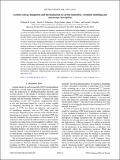Acoustic energy dissipation and thermalization in carbon nanotubes: Atomistic modeling and mesoscopic description
Author(s)
Nicholson, David A.; Jacobs, William M.; Zemer, Hagit; Volkov, Alexey N.; Zhigilei, Leonid V.
DownloadJacobs-2012-Acoustic energy dissipation and thermalization in carbon nanotubes.pdf (6.387Mb)
PUBLISHER_POLICY
Publisher Policy
Article is made available in accordance with the publisher's policy and may be subject to US copyright law. Please refer to the publisher's site for terms of use.
Terms of use
Metadata
Show full item recordAbstract
The exchange of energy between low-frequency mechanical oscillations and high-frequency vibrational modes in carbon nanotubes (CNTs) is a process that plays an important role in a range of dynamic phenomena involving the dissipation of mechanical energy in both individual CNTs and CNT-based materials. The rates and channels through which acoustic energy deposited instantaneously in individual CNTs is dissipated are investigated in a series of atomistic molecular dynamics simulations. Several distinct regimes of energy dissipation, dependent on the initial stretching or bending deformations, are established. The onset of axial or bending buckling marks the transition from a regime of slow thermalization to a regime in which the energy associated with longitudinal and bending oscillations is rapidly damped. In the case of stretching vibrations, an intermediate regime is revealed in which dynamic coupling between longitudinal vibrational modes and the radial “squash” mode causes delayed axial buckling followed by a rapid transfer of energy to high-frequency vibrations. The results of the atomistic simulations are used in the design and parameterization of a “heat bath” description of thermal energy in a mesoscopic model, which is capable of simulating systems consisting of thousands of interacting CNTs. Two complementary methods for the description of mechanical energy dissipation in the mesoscopic model are developed. The relatively slow dissipation of acoustic vibrations in the absence of buckling is described by adding a damping force to the equations of motion of the dynamic elements of the mesoscopic model. The sharp increase in the energy dissipation rate at the onset of buckling is reproduced by incorporating a hysteresis loop into the strain energy that accounts for localized thermalization in the vicinity of buckling kinks. The ability of the mesoscopic model to reproduce the complex multistep processes of acoustic energy dissipation predicted by the atomistic simulations is demonstrated in mesoscopic simulations of free stretching and bending vibrations of individual CNTs.
Date issued
2012-10Department
Massachusetts Institute of Technology. Department of Chemical EngineeringJournal
Physical Review B
Publisher
American Physical Society
Citation
Jacobs, William et al. “Acoustic Energy Dissipation and Thermalization in Carbon Nanotubes: Atomistic Modeling and Mesoscopic Description.” Physical Review B 86.16 (2012). © 2012 American Physical Society
Version: Final published version
ISSN
1098-0121
1550-235X